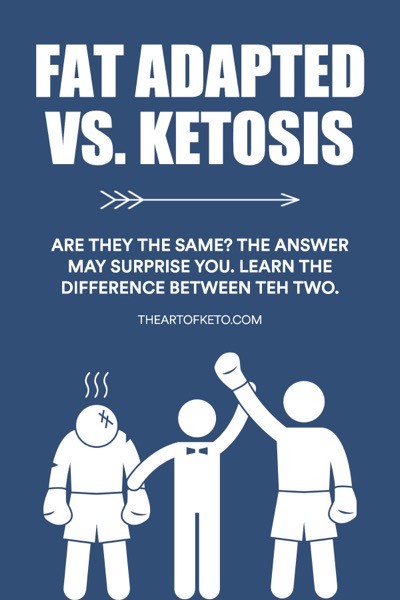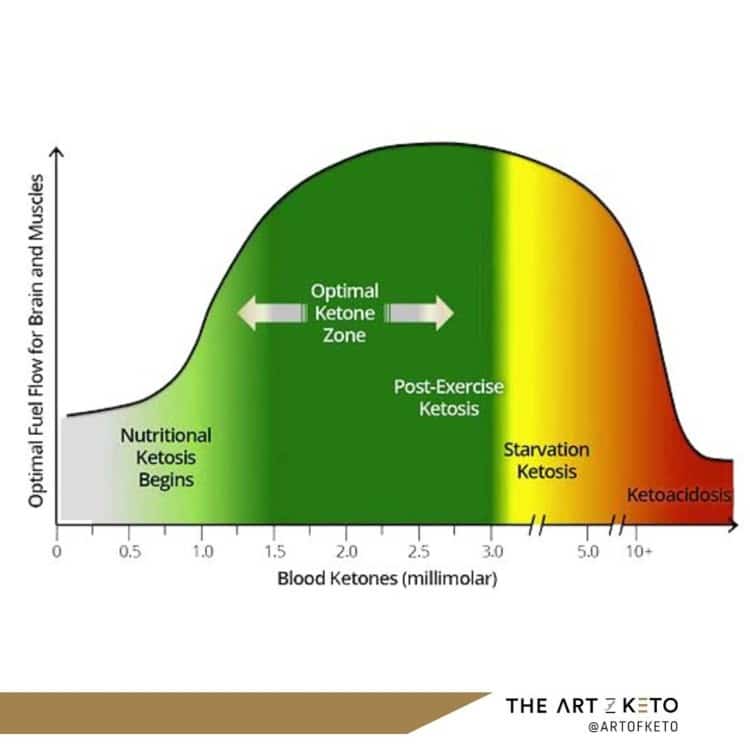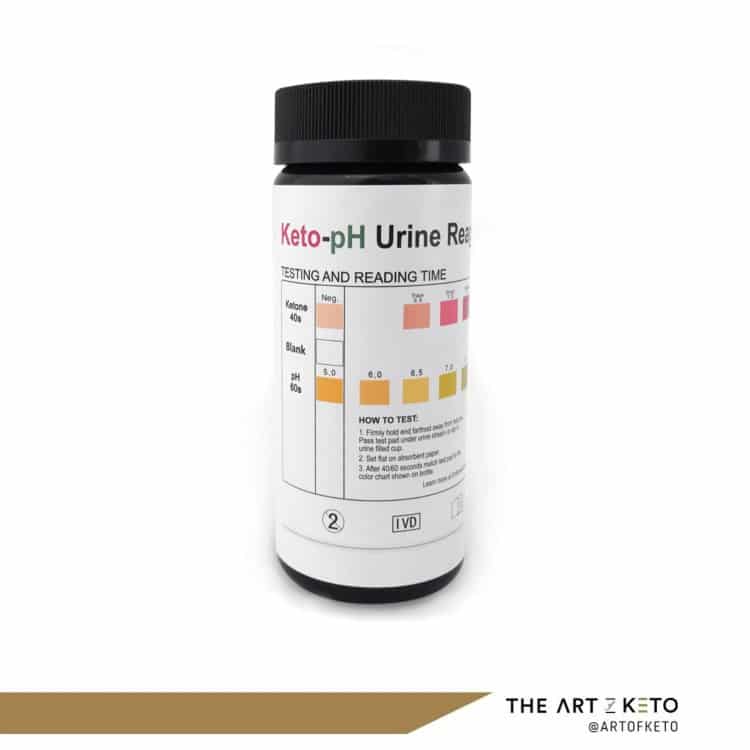For one reason or another, you may want to be fat-adapted without having to go keto. Perhaps you’ve been keto for a while and looking to start incorporating carbohydrates, and now you’re wondering if you can still be fat adapted.
And I would say yes.
As someone who’s intermittently switched between carbohydrate-based and ketogenic diets, you can be fat-adapted without the need to be in ketosis. Still, ketosis may help get you there quicker.
Can you be fat adapted without being in ketosis? You don’t have to be in ketosis to be fat adapted, but ketosis may help you get there much faster.
What’s the difference between fat adapted and ketosis? Fat adapted means you’re efficient at using fatty acids for fuel but may not necessarily be in ketosis. Ketosis is a metabolic state that occurs when ketone bodies are produced at accelerated rates and accumulate in the bloodstream.
In this article, I’ll expand the differences between being fat adapted and being in ketosis, signs you’re fat adapted, how long fat-adaptation lasts, and how to become fat adapted without keto.

Table of Contents
Fat Adapted Vs. Ketosis – What’s The Difference?
People often confuse being fat adapted with being in ketosis, and while they may be similar and closely related, they are not mutually exclusive.
It’s entirely possible to be fat adapted without being in ketosis but to understand why you must understand the difference between the two.
What is fat adaptation?
Simply put, fat adaptation is when your body can efficiently use fat and ketones for fuel.
Under “normal” dietary conditions, i.e., with carbohydrates, the body runs on a mix of carbohydrates, fat, and protein.
During low-intensity exercise (a walk, for example), and to fuel your daily activities, the body relies mostly on the oxidation of fatty acids with few carbohydrates.
As intensity or duration increases, a marathon or a sprint, for example, fat use decreases, and carbohydrate utilization goes up.123
When someone is fat-adapted, the rate at which they can burn fat and ketones for fuel is increased, even at higher intensities, thus reducing (not eliminating) the need for carbohydrates as a fuel source.4
You’ll also notice additional signs and symptoms once you’ve become fat adapted… which I’ll cover later in the article.
However, fat-adaptation doesn’t necessarily mean you’re in ketosis. You may just be efficient at utilizing fats and ketones as a fuel source.
What is ketosis?
When the body’s stores of carbohydrates are depleted, as with what happens from following a ketogenic diet, the body is forced to find an alternative fuel to provide energy.
While we utilize a mix of fats, carbohydrates, and protein on a standard mixed diet, not all organs are capable of using free fatty acids.
Your brain and nervous system are unable to use free fatty acids for fuel, unlike your muscle tissue and other organs; however, both the nervous system and brain can use ketone bodies.
To fuel the brain and nervous system, ketone bodies are created in the liver at an accelerated rate. These ketone bodies accumulate in your bloodstream, causing the metabolic state we refer to as ketosis.Since ketone bodies accumulate in the blood, this can be measured using a blood ketone meter (a more accurate version of the keto urine strips), where ketosis is characterized at being anything above 0.5 mmol/L.5
Ketosis can then be quantified as having a blood concentration above 0.5 mmol/L. Those who are fat adapted may be able to use free fatty acids efficiently as a fuel source but may not necessarily be in ketosis.

How To Become Fat Adapted Without Keto
With all this talk about fat adaptation and keto being different, how can you become fat adapted without following a ketogenic diet?
It’s true that following a ketogenic diet may help, and may get you to that “fat-adapted” state much quicker, but you don’t necessarily have to follow a ketogenic diet to become fat adapted.
However, being in ketosis for some time may help you become fat adapted even when you stop your ketogenic diet.
A ketogenic diet
I know these are tips on how to become fat-adapted WITHOUT keto, but the truth is a ketogenic diet is the quickest and most efficient way to become fat adapted.
When you follow a ketogenic diet and start producing ketones at an accelerated rate, your body begins to up-regulate and develop the mitochondrial machinery to use fats and ketones efficiently.
These enzymes are believed to stay with you far after you’ve creased being on a ketogenic diet.
Fast or intermittent fasting
Without following a ketogenic diet, it’s not uncommon for people to start producing very low levels of ketones overnight while they sleep.
You may have gone 8 – 10 hours by the time you wake up with no food or activity whatsoever, but that doesn’t mean your body hasn’t been using fuel throughout the evening.
Your brain and body are always using energy, even at rest.
By incorporating periods of fasting or extending your fasting window to 12, 16, 18+ hours, you are giving your body a chance to rely more on fat as fuel rather than the food you’ve just consumed.
Periodically fasting or practicing intermittent fasting will increase fatty acid utilization, as well as an increased possibility for small amounts of ketones to be created in the process.
Low ”er” carb – High “er” fat
While you don’t have to eat a strict ketogenic diet, reducing your carb intake slightly is another useful strategy to help with fat adaptation.
After all, if you’re constantly flooding your body with carbohydrates, why would it need to use fat for fuel?
Depending on your level activity would determine the number of carbohydrates to consume, but a good starting point may be around the 100-150 gram amount.
Less if you’re very sedentary or more if you’re incredibly active and include vigorous exercise.
Also, increasing your intake of healthy fats, such as from olive oil, avocados, pasture-raised eggs, grass-fed meats, and fatty fish, will help in addition to lowering carb intake.
Exogenous ketones
Think of taking an exogenous ketone product as an artificial way to ramp up the amount of ketones in your blood.
Your body has to process exogenous ketones, whether your body made them (endogenous) or you ingested them from outside sources (exogenous).
By consuming exogenous ketones, your body may up-regulate and create the transporters required to use this alternative fuel source you’re providing.
MCTs
Medium-chain triglycerides (MCTs) and, more specifically, Caprylic Acid (C8) are another way of introducing ketones into your body.
The difference is, instead of introducing ketones directly (exogenous ketones), consuming MCTs does it indirectly.
Meaning, once ingested, MCTs go straight to your liver, where they become an instant energy source or turned into ketones.
MCTs, which stands for medium-chain triglyceride, is made of 6-12 carbon atoms. The main fatty-acids in MCTs are
- C6 – caprice acid
- C8 – caprylic acid
- C10 – capris acid
- C12 – Laurie acid
C8 is the most effective in converting to ketones, which may make taking C8 specifically an ideal choice, though it cost a little bit more.
My choices for MCTs and C8 Oil
Low-intensity exercise

The primary fuel source during medium to low-intensity exercise relies upon more fat oxidation than carbohydrates.
Including low-intensity exercise, possibly even fasted, may increase and speed up fat adaptation.
How Long Does It Take To Become Fat Adapted
When following a ketogenic diet, it takes most people, on average, three weeks to four weeks to become keto-adapted.
However, it seems fat-adaptation may take a bit longer than merely becoming keto-adapted.
In total, it usually will take 6, 8, and maybe 10-weeks to become truly fat-adapted and not just keto-adapted.
While there is no scientific literature to confirm this, the time frame seems to coincide with what many people experience and report, as shown by the signs and symptoms below.
Do You Produce Ketones When Fat Adapted?
Almost everyone produces ketones at some point. It’s not uncommon for individuals not following a ketogenic diet or trying to become fat-adapted to produce small levels of ketones.
After an overnight fast, a.k.a. sleep, the body may be producing small levels of ketones by the time you wake up.
While you may have a higher chance of producing ketones when fat-adapted, being fat adapted doesn’t necessarily mean you are producing ketones.
Any significant amount of ketones in the bloodstream would only come from being in ketosis.
Can You Be In Ketosis And Not Fat Adapted?
Ketosis is the metabolic state that occurs once your body ramps up ketone production, but that doesn’t necessarily mean you’re efficient at using them yet.Keto adapted, not fat-adapted, generally means the body has minimized its reliance on glucose for fuel and has become more efficient at utilizing ketones, especially in the brain.
A great example to illustrate being in ketosis, but not fat adapted, is the use of the ketostix or urine test strips to test for ketones.
Many individuals, maybe even you, may have noticed unusually high levels of ketones during the first, second, and even third week of starting your ketogenic diet.
After a while, most people start to see a DECREASE in the ketones they measure via their urine.

The reason you may have seen high levels of ketones in your urine was that your body was not yet efficient at using them, i.e., it wasn’t fat adapted. Ketones were being excreted and wasted instead of being used.
This is one of a few reasons you may have felt crummy the first couple of weeks; it’s because your body had a deficient supply of fuel.
As your body up-regulated, it created the necessary enzymes and transporters to utilize ketones for fuel. Naturally, you then began to see fewer ketones on the test strip, and that’s because less of it was being wasted.
This is another reason why I recommend a blood ketone meter if you choose to test.
How Long Does Fat Adaptation Last?
Once you’ve been ketogenic or fat-adapted, I find that you can maintain your fat adaptation indefinitely.
I and others I’ve coached have noticed that we can get into ketosis much faster the 2nd, 3rd, and even 4th time around.
Despite how long we’ve been on a carbohydrate-based diet. This just means that the enzymes and transporters are still there.
How To Know You’re Fat Adapted
Since there’s no way to measure fat-adaptation, at least to the general public, here are some signs that you may be fat-adapted.
Longer between meals
If you’re able to go more extended periods between meals without getting hangry, this is a good sign you may be fat adapted.
Generally, you should be able to go without food for 4-6 hours without needing to snack or chewing your arm off.
More stable energy
Being fat adapted means you can efficiently use fat for fuel when the need arises. If you’re experiencing fewer dips in energy throughout the day, this may be a sign of fat adaptation.
Reduced cravings
As with the ketogenic diet, many people report reduced cravings and increased satiety throughout the day.
You may find yourself with reduced cravings, especially for sugary foods, when you otherwise would have been.
Better endurance
More prolonged, but lower-intensity exercise relies more heavily on fat as a fuel source. If you’re able to workout longer and harder with less reliance on carbohydrates for fuel, you’re on the right path.
The Takeaway
Fat adapted doesn’t necessarily have to be accomplished with a ketogenic diet, though being in ketosis may help you become fat adapted much quicker.
People who’ve been on a ketogenic diet previously realize they can achieve ketosis much quicker the next time they attempt a ketogenic diet.
Using strategies such as fasting, IF, exogenous ketones, and lowering carbohydrates may help you become fat-adapted without the need to follow a ketogenic diet.
In the end, fat adapted vs. ketosis comes down to if you’re producing a sufficient amount of ketones, typically measured as 0.5 mmol/L or higher on a blood ketone meter.
If you’re not, then you are not in ketosis. Fat adapted merely means you’re good at utilizing fats for fuel, but that doesn’t always have to mean being keto.
